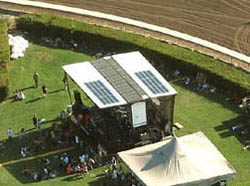
Founded in 1994 by Lollapalooza veteran Kevin Lyman, the Vans Warped Tour has now grown to feature as many as 100 bands per stop, spread among numerous stages. This year (2008), North America’s longest running tour traveled to well over 40 different cities, sometimes going from stop to stop for more than a full week without a day off.
A few years ago, as part of the Warped Eco Initiative (WEI) to “clean up and green up,” the tour deployed a stage featuring a modest solar-powered PA.
This time out, however, Lyman sought a sonic upgrade, where the solar power source could produce enough electrical energy to support a much larger, more dynamic concert sound system, as well as drive all stage monitors and backline gear.
Lyman discussed his goals with long-time acquaintance Tim Allyn, head of California-based Allyn Consulting, a sustainability design consultancy, who in turn brought Dave Rat of Rat Sound Systems into the conversation.
The basis of the effort is a Stage-Tech Solar 250 mobile stage featuring a powerful built-in solar system comprised of off-the-shelf components. Solar panels are mounted permanently to the stage roof, feeding charge controllers that infuse the large batteries, which in turn feed inverters that convert the DC energy to solid, stable 120 volts AC. (See our Photo Gallery for a look at the solar and audio system components during a tour stop.)
The setup is capable of delivering up to 80 amps (4,000 watts of continuous power and 8,000 watts peak) for up to eight hours, with a natural gas generator also onboard as a backup. If needed, it activates (via sensors) within milliseconds for a seamless transition.
The entire stage, with a floor measuring 32 feet by 24 feet, can be erected with its onboard hydraulics and completely set up – PA included – in the same or less time than a stage fed by house or generator power. No special considerations are required.
EAW also joined the project, with Rich Frembes and Jeff Rocha specifying a house PA capable of commensurate SPL and impact at distances of at least 75-80 feet, along with stage monitoring and backline. While the solar system can comfortably deliver 80 amps, Frembes and Rocha sought to draw about half that amount to provide an extra comfort zone.
Just two Lab.gruppen FP 10000Q four-channel power amplifiers were capable of driving the entire main loudspeaker system, which was comprised of eight full-range EAW KF730 line array modules (four per side) as well as four EAW BH760 horn-loaded subwoofers (two per side). One FP 10000Q channel handled four KF730 MF/HF (16-ohm) sections, another channel drove the LF sections of those boxes, and the remaining two channels each fed a BH760 sub.
The FP 10000Q is rated to draw 25.9 amps from a 115 VAC line using 1/8 power pink noise at four ohms, all channels driven. But a more dynamic music signal actually draws considerably less average current, which Frembes and Rocha estimated would be at 12 amps or so, and this was indeed confirmed under show conditions.
The entire PA, including EAW UX8800 digital processing as well as the EAW NT powered loudspeakers used as monitors, only needed about 30 amps total.
The rest of the gear – backline and a Mackie TT24 digital console utilized by Mix Engineer Tom McNabb for both house and monitors – drew less than 10 additional amps.
Over the entire course of the tour, the solar system performed solidly, without a glitch or need for the backup generator to take over. This, even with some consecutive overcast/rainy days while the PA was still run full tilt for eight hours at a time. (See our Photo Gallery for images of both the solar and audio systems on this tour.)
